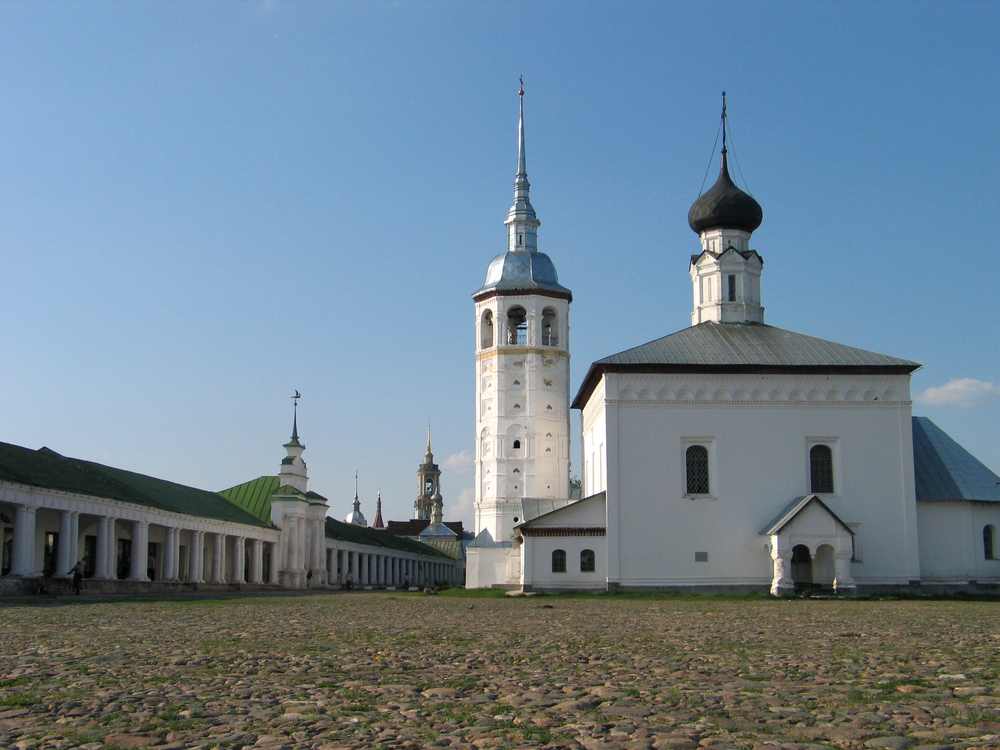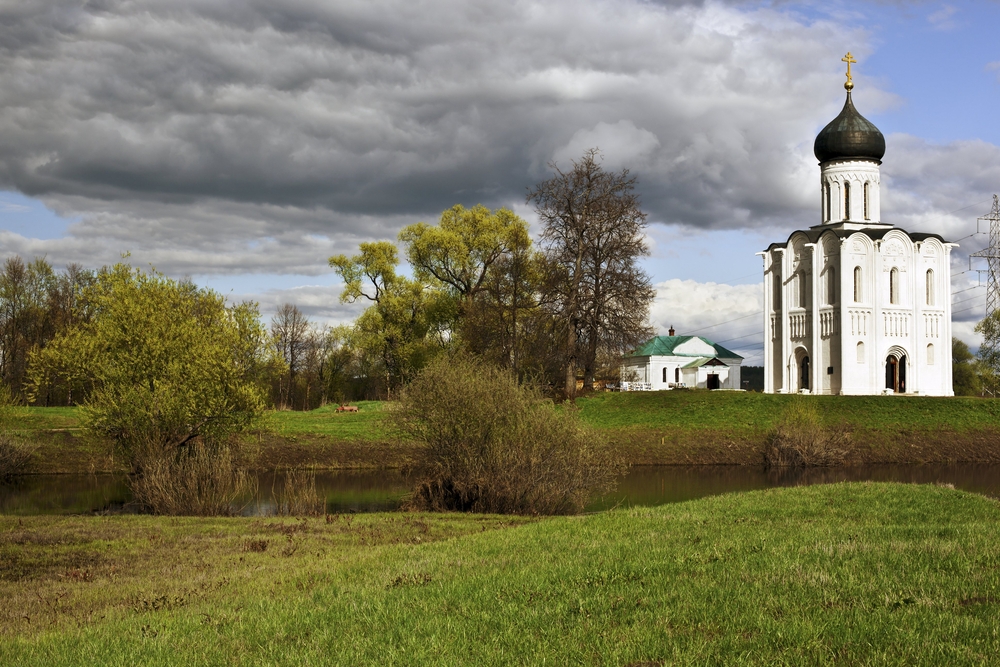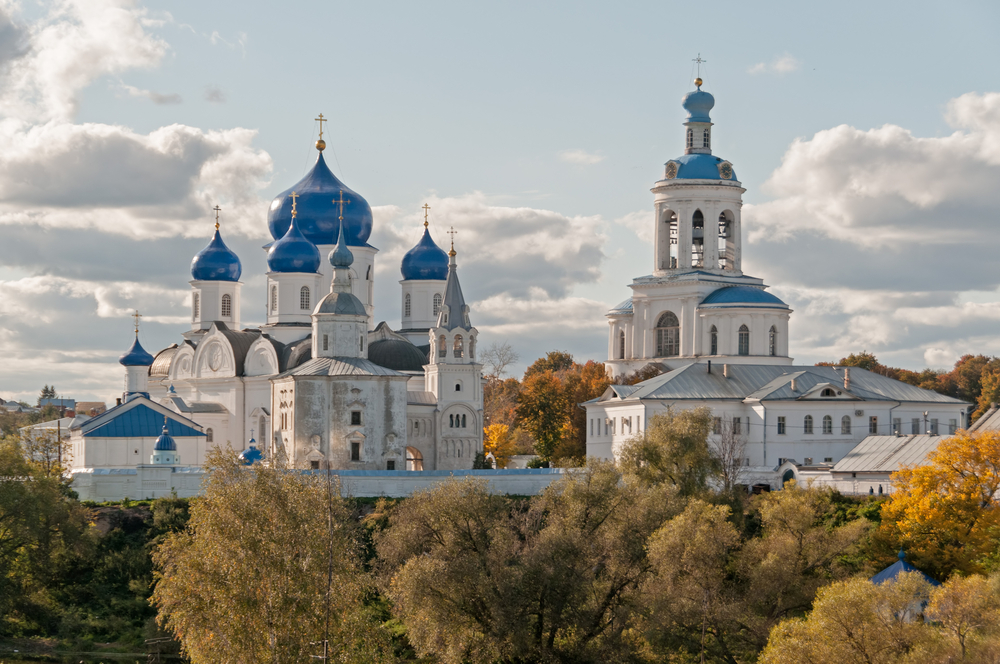White Monuments of Vladimir and Suzdal
Architectural masterpieces from the 12th &13th centuries
Country: Russia | Type: Cultural | Theme: Christian, Religious Structure
Introduction to the White Monuments of Vladimir and Suzdal
The White Monuments of Vladimir and Suzdal consist of eight historical architectural masterpieces from the 12th to 13th centuries which are outstanding examples of the legacy left by the Grand Prince Andrei Bogolyubsky who brought the seat of power of the Kievan Rus to Vladimir.
The artistic monuments are scattered within four proximate locations in the Vladimir Oblast, most of which were constructed in the mid-12th century and a precious few later on became blueprints for some of Russia’s most important buildings.
Vladimir and Suzdal are considered as artistic centers of Russian medieval architecture and are parts of the Golden Ring—a circle of eight cities northeast of Moscow which are known for their significance in Russian history and the establishment of the Russian Orthodox Church.
In Vladimir, three great white stone monuments can be found along the stretch of M7 (Ulitsa Bolshaya Moscovskaya in Vladimir). Tourists entering the city from Moscow will first find the 12th century Golden Gates in the middle of the road. This ancient city gate used to be made of oak wood gilded with shining copper, giving it a ‘golden’ façade. It stands as the remaining piece of a 12th century four-sided defense tower with a church at its topmost platform. Today, it houses the exhibit of Vladimir-Suzdal’s military history.
Following the M7 further east, visitors will easily see the Cathedral Square (Sobornaya Ploschad) at the right side of the road, east of the Sudogoskoye shosse intersection. The square bears a modest monument of Vladimir Ilyich Lenin and at the south is the city’s historically famous 12th century Cathedral of the Assumption. This grandiose six-pillared, five golden-domed cathedral that was built within the town Kremlin, was the largest Russian cathedral for about 300 to 400 years after its construction and later became the foundation of Moscow’s eponymous cathedral.
Moving past the pastel-yellow three-storey Children’s Museum Complex and Art Gallery, visitors can stroll to the single-domed Cathedral of St. Demetrius and admire its one thousand intricate exterior stone carvings representing a mix of Byzantine, Roman and early Renaissance art.
At the northeastern outskirts of Vladimir is the quaint village of Bogolyubovo, which owes its name to Prince Andrei. In the mid-12th century, the prince built his palace residence and the uniquely situated Church of the Intercession on the Nerl. Except for the Staircase Tower of Bogolyubsky Castles, the remains of the Royal Palace may be difficult to distinguish from the current Cathedral of the Nativity of the Virgin as both palace and Bogolyubovo monastery were repeatedly ravaged and rebuilt over the centuries. However the whole convent stands out from the right side of M7 as the tower, church and the five-domed Cathedral of the Icon of Our Lady are clad in white and topped with royal blue bulb domes and gilded crosses. About two kilometers southwest of the palace walls is one of the most famous Russian white stone church architecture, the Church of the Intercession on the Nerl. The Intercession is a simple and solemn single gray-domed church often described as a ‘floating church’ because when the river overflows and it looks like it is floating on water.
Moving north, the Ulitsa Lenina courses through the historic town of Suzdal. Suzdal is known as the jewel of the Golden Ring and is a historic museum home to more than 300 stone and wooden masterpieces which were intentionally preserved for tourism. The town Kremlin, which lies at the southwestern meander of the Kamenka river, is the oldest part of the historic town. Surrounded by medieval earthen ramparts, the Kremlin keeps Suzdal’s oldest standing church, the Cathedral of the Nativity of the Theotokos. The cathedral was originally built in 1102 and was rebuilt in 1222 in white stone. The cathedral has been long admired for its blue domes marked by gilded stars and its 13th century Golden Doors where Biblical scenes were meticulously engraved in copper.
A myriad collection of antique structures and a few historic monasteries line up along Ulitsa Lenina and throughout Suzdal’s thoroughfares. Visitors will be able to observe the similarities in the architectural style of the buildings, two of which are the tent-roofed of belfries (a prevalent style in the 16th and 17th centuries) and rows of spade-shaped or semicircular kokoshniki below the cylindrical turrets of cupolas and atop the cubed sides of the churches.
Situated at the north end of Ulitsa Lenina, the Monastery of Our Saviour and St. Euthymius stands out as the most fortified monastery in Suzdal. Founded in the mid-14th century, the monastery is enclosed by a 6-meter thick walls and 12 massive conical-roofed defense towers. The 16th century Cathedral of Transfiguration of the Saviour is noted for its austere form, echoing the tradition of Vladimir style of church architecture.
The Church of Saints Boris and Gleb, found in the village of Kideksha, was built under the order of Yuri Dolgoruky (The Long-Armed) in 1152 as a tribute to the murdered saints and sons of the Kievan Prince Vladimir I The Great. The church is a modest single-domed Vladimir-styled structure with three cylindrical turrets and a solemn exterior. It is said that the Boris and Gleb church is the oldest white limestone monument in all of Vladimir.
Among the key figures which initiated the political and religious development of Vladimir and Suzdal were sons of Vladimir I The Great: Boris, Gleb, and Yaroslav The Wise. The neighboring city of Rostov first was an earlier principality and religious center of the Kievan Rus’. The seat of power eventually expanded to Suzdal when Vladimir II Monomakh appointed his son, Yuri Dolgoruky to rule the northeastern principality of Kievan Rus’ in 1125.
By recorded historical accounts, Suzdal is first mentioned in 1024 and Vladimir in 1108. In 1152, Prince Yuri establishes the Church of Sts. Boris and Gleb and in 1157, his son, Prince Andrei Bogolyubsky succeeds the Rus’ throne. Vladimir’s rise to historical significance began when Prince Andrei transferred the throne from Kiev to Vladimir. Around this time, the prince had a holy vision of the Theotokos (Virgin Mary) who urged him to place the icon of the Holy Virgin in Vladimir and build a church where the icon-bearing horses refused to go further.
In 1158, the prince thus ordered the construction of the Cathedral of the Assumption in Vladimir. He dedicated it to the Theotokos and intended it to be the religious centre of Russia. The original 12th century frescoes were destroyed by Mongols in 1238 and were repainted by icon masters Andrei Rublev and Daniil Chyernyi in 1408, particularly the Last Judgment. In 1475, Italian Renaissance architect Aristotele Fioravanti was instructed to design Moscow’s Assumption Cathedral in the image of its eponymous predecessor in Vladimir. Fiorovanti’s architectural version of the Vladimir Assumption Cathedral later became the basis for other architectural monuments in Russia.
In the years between 1158-1165, Prince Andrei built the Golden Gates in Vladimir, the Church of the Intercession on the Nerl and a castle-fortress in Bogolyubovo, which became his residence until his murder in 1174. The gates, originally built in 1164, are the only remaining parts of a century defense cubic tower which defended Vladimir from the Mongol-Tatar attacks including the one which ravaged the city in 1238 and the bombardment of the Polish-Lithuanian siege in the 17th century.
In 1194, Vselovod III The Big Nest ordered the construction of the Cathedral of St. Demetrius, a royal church known for its thousand façade stone carvings showing a blend of Christian and pagan imagery.
Vladimir and Suzdal’s wooden and brick monuments perished over the centuries under the repeated fires and attacks of the Mongol-Tatars, white limestone monuments flourished from the 16th century. However, the principality’s first known white monument is the modest and austere church at a little known village east of Suzdal, the Church of Saints Boris and Gleb.
The principality later broke down because internal and external conflicts—the constant struggle for the throne and the Mongol-Tatar yoke.
Vladimir and Suzdal, which lay 38 kilometers (24 mi) south and north of one another, are cities located at the center of Vladimir Oblast and are bounded by two main international hubs: Moscow from the west and Nizhny Novgorod in the east.
From Moscow or Nizhny Novgorod, the city of Vladimir can easily be accessed via train, bus, or private vehicle. Likewise, land transportation such as buses, trolleybuses and rented vehicles are quite common in travelling around the city and to other towns in the Oblast.
Going to Vladimir
By train: From Moscow, tourists can take the electrichka bound for Vladimir at Kursky station or a long-distance train which leaves from Kursky, Yaroslavsky and Kazansky stations. The average train ride to the city takes three hours. A special express ride which takes 2 ½ hours is also available from Moscow at 6pm and leaves from Vladmir at 7:30 in the morning.
From Nizhny Novgorod, a direct express train leaves from the Gorky Moscovsky station at 4:10pm and return from Vladimir at 7 o’clock in the morning. This train makes a few short stops along the way and the entire ride up to Vladimir takes 3 ½ hours.
By bus: Buses from Moscow leave at the Shelkovskaya metro station daily and head off to Vladimir and cities beyond it. At the minimum, 10 buses leave every half hour or even less and the trip takes three hours or longer depending on Moscow traffic. On the other hand, buses at Nizhny Novgorod leave from Kanavino bus station and take five hours to arrive at Vladimir
Vladimir’s central bus terminal operates buses going to each town in the Oblast in addition to neighboring cities such as Moscow, Nizhny Novgorod, Ivanovo and so on. A station for private minibuses going to Moscow, Gus-Khrustalny, Murom and Ivanovo can be found at the square near the central terminal. These private minibuses leave as soon as the vehicles fill up and are convenient for tourists who would like to travel at their own pace.
By private vehicle or rented car: Tourists coming from Moscow and Nizhny Novgorod can follow M7 as the main thoroughfare going to the city of Vladimir.
Travelling around the city, tourists can ride trolleybus no. 5 which runs a route through Vladimir’s historical centre from the train station and through Ulitsa Bolshaya Moscovskaya where all three white-stone monuments—the Golden Gates, the Cathedral of the Assumption and the Cathedral of St. Demetrius—can be found alongside the avenue.
Going to Bogolyubovo
Bogolyubovo is a settlement in the Suzdalsky district and is situated some 10 kilometers (6.2 miles) east of the city of Vladimir along the M7 highway going to Nizhny Novgorod. The settlement is where the remains of the palace residence of Andrei Bogolyubsky and the Church of the Intercession of the Holy Virgin on the Nerl are located. Visitors to this town can take a day trip from Vladimir via bus and return to the city by night. Tourists with private or rented vehicles can just follow M7 eastwards until they reach the first settlement they encounter. The prince’s castle can be found at the immediate side of the road with the five blue-domed Cathedral of the Icon of Our Lady behind it. Past the convent, a road at the right will lead to the railway crossing where tourists can park their vehicles and start a two-kilometer pilgrimage to the water meadow where the Church of the Intercession is located.
Going to Suzdal
As there are no railway system in Suzdal, the only viable options to visiting this historic town are via bus or car. From Vladimir, the M7 highway splits up north, with the road forking to the left becoming Ulitsa Lenina and crossing into the heart of Suzdal. Intercity and local buses which course through Suzdal and neighboring cities such as Vladimir, Ivoanovo, Kostroma, Yaroslavl, Ryazan and Minsk (Belorussia).
One bus from Moscow leave from the Shelkovskaya station daily although the more practical route would be to visit or travel to Vladimir first and take the public bus or private tour bus from the Kursky terminal to Suzdal.
Going to Kideksha
The small village of Kideksha is the nearest eastern settlement to Suzdal, lying at four kilometers east of the historic town. The village is known for the Church of Saints Boris and Gleb which can easily be reached via bus or car on a quick day trip or privately arranged tour from Suzdal.
Golden Ring Tour: Originally consisting of eight cities, the Golden Ring is a well-known tourist itinerary northeast of Moscow. These eight cities, namely Sergiev Posad, Pereslavl Zalessky, Rostov Veliky, Yaroslavl, Kostroma, Ivanovo, Suzdal and Vladimir, geographically form an ring of route from Moscow, and are accessible to and from each other via trains and buses. They showcase similar forms of architecture in churches and monastic ensembles, most of which are capped with onion-shaped cupolas in green, blue and gold.
Key Facts
Inscribed:1992
Nearest City:Moscow
Province:Vladimir Oblast
Coordinates: Lat: 56.15000, Long: 40.41666
Accessibility:Easy
Services:Extensive
Highlights
- In Vladimir: Cathedral of the Assumption, The Golden Gates, Cathedral of St. Demetrius
- In Bogolyubovo: Castle remnants of Andrei Bogolyubskii, The Church of the Intercession on the Nerl
- In Suzdal: Suzdal Kremlin with the Cathedral of the Nativity, The Monastery of St. Euthymius
- In Kideshka: The Church of Sts. Boris and Gleb



